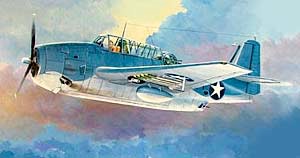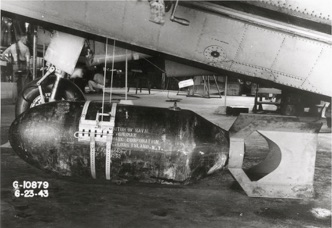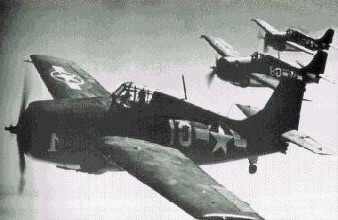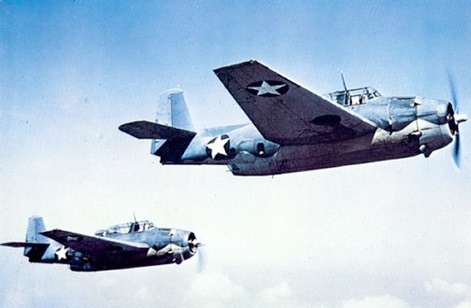TBF-1 Avenger
Grumman TBF-1 Avenger
Soliciting for the TBD Devastators replacement, the TBF design by Grumman would win the bid and hastily be ordered by the Navy in April 1940. Upon holding a ceremony for their new Plant 2 and to reveal the new TBF’s to the public on December 7, 1941, Grumman soon found out that Pearl Harbor was attacked that same day by the Imperial Japanese Navy. Soon thereafter with the US entering the war, Grumman scrambled to mass produce the prototype XTBF-1 into the TBF-1 Avenger (some say the name Avenger was given after the attack of Pearl Harbor, but other sources say that name was thought of in October, two months earlier of the same year). By June
1942, 145 TBF-1 Avengers were delivered to the Navy.


By 1943, however, Grumman would phase out the Avenger for the new F6F Hellcat. Eastern Aircraft (General Motors) would take over production of the Avengers and rename the the plane the TBM and TBM-3 with a more powerful motor and wing hardpoints for drop tanks and rockets. There were several other variants to the TBF and TBM’s during the war, and even a Royal Navy, New Zealand and Canadian version. All in all there were close to 10,000 aircraft built.


The TBF could fit a crew of three. It was 41 feet long, had a wingspan of 54 ft (also incorporated the Sto-wing for the aircraft carriers), and housed a Wright R-2600-20 radial engine at 1900 hp with its maximum speed at 275 mph, and had a range of 1,000 miles.
Nose mounted was a .30 inch M1919 Browning machine gun (early models), two .50 inch wing mounted M2 Browning machine guns, one .50 inch dorsal mounted M2 Browning machine gun, and one .30 inch ventral mounted M1919 Browning machine gun. It could carry up to eight 3.5 inch rockets, 5 inch rockets, or high velocity aerial rockets. In its belly it could carry either a payload of 2,000 lbs. of bombs, or one 2,000 lb. Mark 3 torpedo.



Six Avengers were expedited and flown in the memorable Battle of Midway, but only 1 returned badly damaged with one of its gunners killed and an injured radioman. Nonetheless, the TBF’s were paramount in the drawing away of enemy air patrols so that the American dive bombers could successfully hit the Japanese carriers.
The Avengers took part in many leading attacks in the war. The battle in the Eastern Solomons on board the Saratoga and Enterprise, cost the fleet seven aircraft. But even with the loss, the 24 TBF’s present that day were able to sink the light carrier Ryūjō and one dive bomber.
The list of harrowing feats accomplished by the Avenger is long. They include the sinking of the Hiei at Guadalcanal, 30 submarines including the I-52, and the battleship Yamato. Some would say that the TBF Avenger was the most successful naval strike aircraft ever built.
On August 17, 1942 in a simulated air attack on a target in Lake Washington opposite Leschi, four Avenger torpedo bombers were instructed to bomb the target while three F4F-4 Wildcats were positioned in defense.


In a report by the International Archaeological Research Institute in December of 1996, the four Avengers were engaged in a (Tactics-K) mock torpedo run at 200 knots, and the three Wildcats were opposing the run from ahead at 300 knots. The pilot of the Wildcat (BuNo #4097), Ensign James J. Kinsella, held his attack too long and collided with the Avenger (BuNo #00539).
In an eyewitness accord of what happened, Sam Groff, a Seattle Times cartoonist who was out fishing that day, said that he saw 5 planes (3 Avengers and 2 Wildcats) flying in formation when one of the Avengers wing kept dipping lower and lower and eventually struck one of the Wildcats.
Mrs. Marshall Dwyer saw from her window, the Wildcat crash into the lake, and just a moment before she saw the pilot bail out with his chute not opening until right before he hit the water. The pilot, Ensign James J. Kinsella, who was picked up by Herman Gumbert on an outboard boat, suffered only minor injuries, and a pair of broken goggles. (Seattle Times/Seattle PI August 18, 1942)
The pilot of the Avenger Ensign F.W. Janney and Gunner Charles W. Price escaped from their aircraft before it sank. Unfortunately, Radioman Bernard J. Viscovich was trapped in the plane and drowned in the sinking.
Later, it was determined that 100% fault lie with Ensign James J. Kinsella of the Wildcat.
The Avenger lies in 170 feet of water in Lake Washington.


XTBF-1
TBF-1C

Side scan imagery by Ben Griner - Puget Sound Divers


-
-Home

